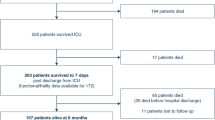Abstract
Background
The present study aimed to evaluate the prognostic value of preoperative changes in sequential organ failure assessment (SOFA) score, daily norepinephrine (NE) dose, lactate, C-reactive protein, and white blood cell count among patients with colectomy in the intensive care unit (ICU).
Methods
We performed a retrospective analysis of 77 colectomized patients (30 female, 47 male) who were treated in a single tertiary-level mixed ICU during 2000–2009.
Results
The underlying conditions leading to colectomy included sepsis (31 patients), cardiovascular operations (21 patients), and fulminant Clostridium difficile colitis (25 patients). The 28-day mortality was 53.3 % (41/77). Nonsurvivors had significantly higher median values than survivors (p < 0.05) for the following parameters: admission SOFA [10.0 (25th–75th percentile 8.0–13.0) vs. 9.0 (6.5–10.0)], highest SOFA [14.0 (12.0–16.0) vs. 12.5 (9.5–14.5)], operative day lactate level (6.3 vs. 2.2 mmol/L), and NE dose (16.8 vs. 9.3 total mg/day). During the last three preoperative days, significant increases were observed in total SOFA score (p < 0.001) and in cardiovascular (p < 0.001), coagulation (p = 0.017), renal (p < 0.01), and respiratory (p < 0.001) SOFA subscores, without statistically significant differences between nonsurvivors and survivors. Increasing Glasgow Coma Scale score, preoperative lactate level, and NE dose were significantly associated with mortality.
Conclusions
It should be prospectively studied whether preoperatively increasing lactate level and NE dose are surrogate markers for early laparotomy among ICU patents with colitis.
Similar content being viewed by others
References
Marshall JC, Christou NV, Meakins JL (1993) The gastrointestinal tract: the “undrained abscess” of multiple organ failure. Ann Surg 218:111–119
Carrico CJ, Meakins JL, Marshall JC et al (1986) Multiple-organ-failure syndrome. Arch Surg 121:196–208
Wilmore DW, Smith RJ, O’Dwyer ST et al (1988) The gut: a central organ after surgical stress. Surgery 104:917–923
Deitch EA, Kemper AC, Specian RD et al (1992) A study of the relationship among survival, gut-origin sepsis, and bacterial translocation in a model of systemic inflammation. J Trauma 32:141–147
Paugam-Burtz C, Dupont H, Marmuse JP et al (2002) Daily organ-system failure for diagnosis of persistent intra-abdominal sepsis after postoperative peritonitis. Intensive Care Med 28:594–598
Anderson ID, Fearon KC, Grant IS (1996) Laparotomy for abdominal sepsis in the critically ill. Br J Surg 83:535–539
Van Ruler O, Kiewiet JJ, Boer KR et al (2011) Failure of available scoring systems to predict ongoing infection in patients with abdominal sepsis after their initial emergency laparotomy. BMC Surg 11:38
Laurila J, Laurila PA, Saarnio J et al (2006) Organ system dysfunction following open cholecystectomy for acute acalculous cholecystitis in critically ill patients. Acta Anaesthesiol Scand 50:173–179
Lamontagne F, Labbe AC, Haeck O et al (2007) Impact of emergency colectomy on survival of patients with fulminant Clostridium difficile colitis during an epidemic caused by a hypervirulent strain. Ann Surg 245:267–272
Abou Chakra CN, Pepin J, Valiquette L (2012) Prediction tools for unfavourable outcomes in Clostridium difficile infection: a systematic review. PLoS One 7:e30258
Sipola S, Syrjälä H, Koivukangas V et al (2013) Colectomy in intensive care patients: operative findings and outcomes. World J Surg 37:333–338. doi:10.1007/s00268-012-1836-1
Knaus W, Draper E, Wagner P, Zimmerman J (1985) APACHE II: a severity of disease classification system. Crit Care Med 13:818–829
Vincent JL, Moreno R, Takala J et al (1996) The SOFA (Sepsis-related Organ Failure Assessment) score to describe organ dysfunction/failure: on behalf of the working group on sepsis-related problems of the European Society of Intensive Care Medicine. Intensive Care Med 22:707–710
Vincent JFCCM, de Mendonca A, Cantraine F et al (1998) Use of the SOFA score to assess the incidence of organ dysfunction/failure in intensive care units: results of a multicenter, prospective study. Crit Care Med 26:1793–1800
Perera AD, Akbari RP, Cowher MS et al (2010) Colectomy for fulminant Clostridium difficile colitis: predictors of mortality. Am Surg 76:418–421
Longo WE, Mazuski JE, Virgo KS et al (2004) Outcome after colectomy for Clostridium difficile colitis. Dis Colon Rectum 47:1620–1626
Dallal RM, Harbrecht BG, Boujoukas AJ et al (2002) Fulminant Clostridium difficile: an underappreciated and increasing cause of death and complications. Ann Surg 235:363–372
Darras S, Paineau J, Patra P et al (2011) Prognostic factors of ischemic colitis after infrarenal aortic surgery. Ann Vasc Surg 25:612–619
Jarvinen O, Laurikka J, Sisto T et al (1996) Intestinal ischemia following surgery for aorto-iliac disease: a review of 502 consecutive aortic reconstructions. Vasa 25:148–155
Jarvinen O, Laurikka J, Salenius JP et al (1999) Mesenteric infarction after aortoiliac surgery on the basis of 1752 operations from the National Vascular Registry. World J Surg 23:243–247. doi:10.1007/PL00013190
Ludwig KA, Quebbeman EJ, Bergstein JM et al (1995) Shock-associated right colon ischemia and necrosis. J Trauma 39:1171–1174
Levandoski G, Deitrick JE, Brotman S (1988) Necrosis of the colon as a complication of shock. Am Surg 54:621–626
Byrn JC, Maun DC, Gingold DS et al (2008) Predictors of mortality after colectomy for fulminant Clostridium difficile colitis. Arch Surg 143:150–154
Pepin J (2004) Clostridium difficile-associated diarrhea in a region of Quebec from 1991 to 2003: a changing pattern of disease severity. CMAJ 171:466–472
Bhangu S, Bhangu A, Nightingale P et al (2010) Mortality and risk stratification in patients with Clostridium difficile-associated diarrhoea. Colorectal Dis 12:241–246
Reissfelder C, Sweiti H, Antolovic D et al (2011) Ischemic colitis: Who will survive? Surgery 149:585–592
Author information
Authors and Affiliations
Corresponding author
Rights and permissions
About this article
Cite this article
Sipola, S., Syrjälä, H., Koivukangas, V. et al. Impact of Preoperative Organ Failures on Survival in Intensive Care Unit Patients with Colectomy. World J Surg 37, 1647–1651 (2013). https://doi.org/10.1007/s00268-013-2041-6
Published:
Issue Date:
DOI: https://doi.org/10.1007/s00268-013-2041-6




